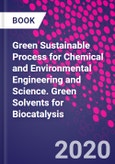Green Sustainable Process for Chemical and Environmental Engineering and Science: Green Solvents for Biocatalysis delivers an in-depth overview of biocatalysis in green solvents for industrial applications, also including outlines of sustainable methodologies in the area of organic chemistry, agriculture, analytical chemistry and engineering and pharmaceutical sciences. The book provides unique content in the area, making it a great source for information for undergraduate, postgraduate students, faculty, R&D professionals, production chemists, environmental engineers and industrial experts.
Please Note: This is an On Demand product, delivery may take up to 11 working days after payment has been received.
Table of Contents
1. Fundamentals and solvent parameters for biocatalysis2. Ionic-liquids for biocatalysis
3. Eutectic solvents for biocatalysis
4. Green solvents for peptide antibiotics
5. Biocatalysis in aqueous media
6. Green solvents based biocatalysis in pharmaceutical applications
7. Supercritical water for biocatalysis
8. Supercritical CO2 for biocatalysis
9. Biosolvents for biocatalysis
10. Industrial biocatalysis
11. Green solvents for nucleic acid catalysis
12. Engineering strategies in Biocatalysis
13. Green solvents' effect on Enzyme kinetics
14. Green organic carbonates in biocatalysis
15. Green fluorosolvents for biocatalysis
16. Switchable solvents for biocatalysis
17. Green solvents based biocatalysis in molecular biology
18. State of the art and perspectives of green solvents in biocatalysis
Authors
Rajender Boddula CAS Key Laboratory of Nanosystems and Hierarchical Fabrication, National Center for Nanoscience and Technology, China. Dr. Rajender Boddula is currently working as CAS-PIFI Fellow in the CAS Key Laboratory of Nanosystems and Hierarchical Fabrication, National Center for Nanoscience and Technology, Beijing, China. He has published many scientific articles in international peer-reviewed journals and has authored nine book chapters, and also serving as editorial board member and referee for reputed international peer-reviewed journals. His specialized areas of energy conversion and storage technologies, which include nanomaterials, graphene, polymer composites, heterogeneous catalysis, photoelectrocatalytic water splitting, biofuel cell, and supercapacitor applications Mohd Imran Ahamed Department of Chemistry, Faculty of Science, Aligarh Muslim University, Aligarh, India. Dr. Mohd Imran Ahamed is a research associate in the Department of Chemistry, Faculty of Science, Aligarh Muslim University, Aligarh, and he has received his Ph.D on the topic "Synthesis and characterization of inorganic-organic composites heavy metals selective cation-exchangers and their analytical applications� from Aligarh Muslim University India in 2019. He has published several research and review articles in SCI journals. His research focuses on ion-exchange chromatography, wastewater treatment and analysis, actuators, enzymatic biofuel cell, and electrospinning. Dr. Ahamed has published 18 research articles in international journals of repute, more than fifteen book chapters, and 20 published by renowned international publishers. Abdullah M. Asiri Chemistry Department, Center of Excellence for Advanced Materials Research, King Abdulaziz University,Jeddah, Saudi Arabia. Prof. Abdullah M. Asiri is the Head of the Chemistry Department at King Abdulaziz University since October 2009 and he is the founder and the Director of the Center of Excellence for Advanced Materials Research (CEAMR) since 2010 till date. He is the Professor of Organic Photochemistry. His research interest covers color chemistry, synthesis of novel photochromic and thermochromic systems, synthesis of novel coloring matters and dyeing of textiles, materials chemistry, nanochemistry and nanotechnology, polymers and plastics. A major achievement of Prof. Asiri is the discovery of tribochromic compounds, a class of compounds which change from slightly or colorless to deep colored when subjected to small pressure or when grind. This discovery was introduced to the scientific community as a new terminology published by IUPAC in 2000. This discovery was awarded a patent from European Patent office and from UK patent. He is also a member of the Editorial Board of various journals of international repute. He is the Vice- President of Saudi Chemical Society (Western Province Branch). He holds four USA patents, more than 800 Publications in international journals, seven book chapters, and ten books








